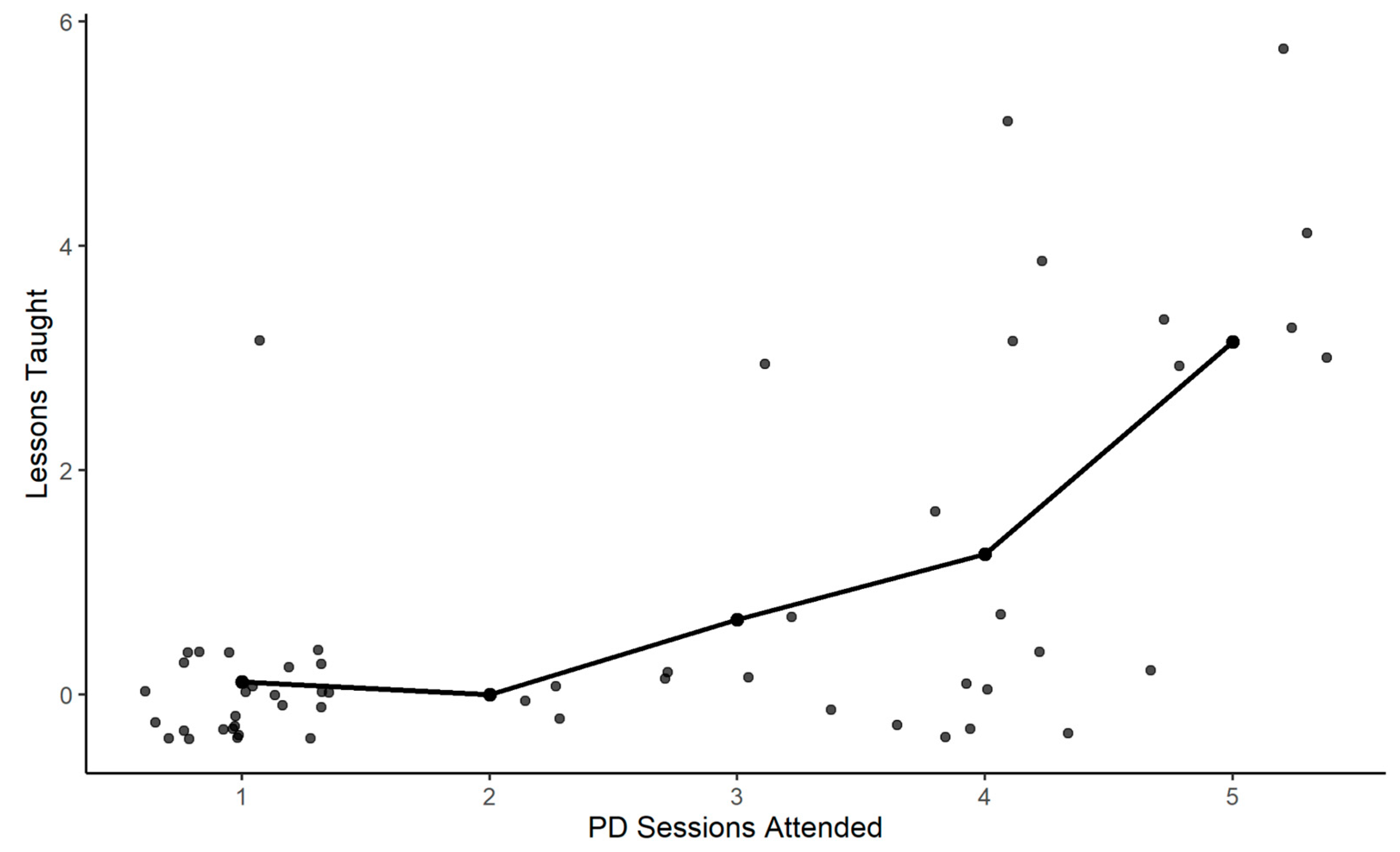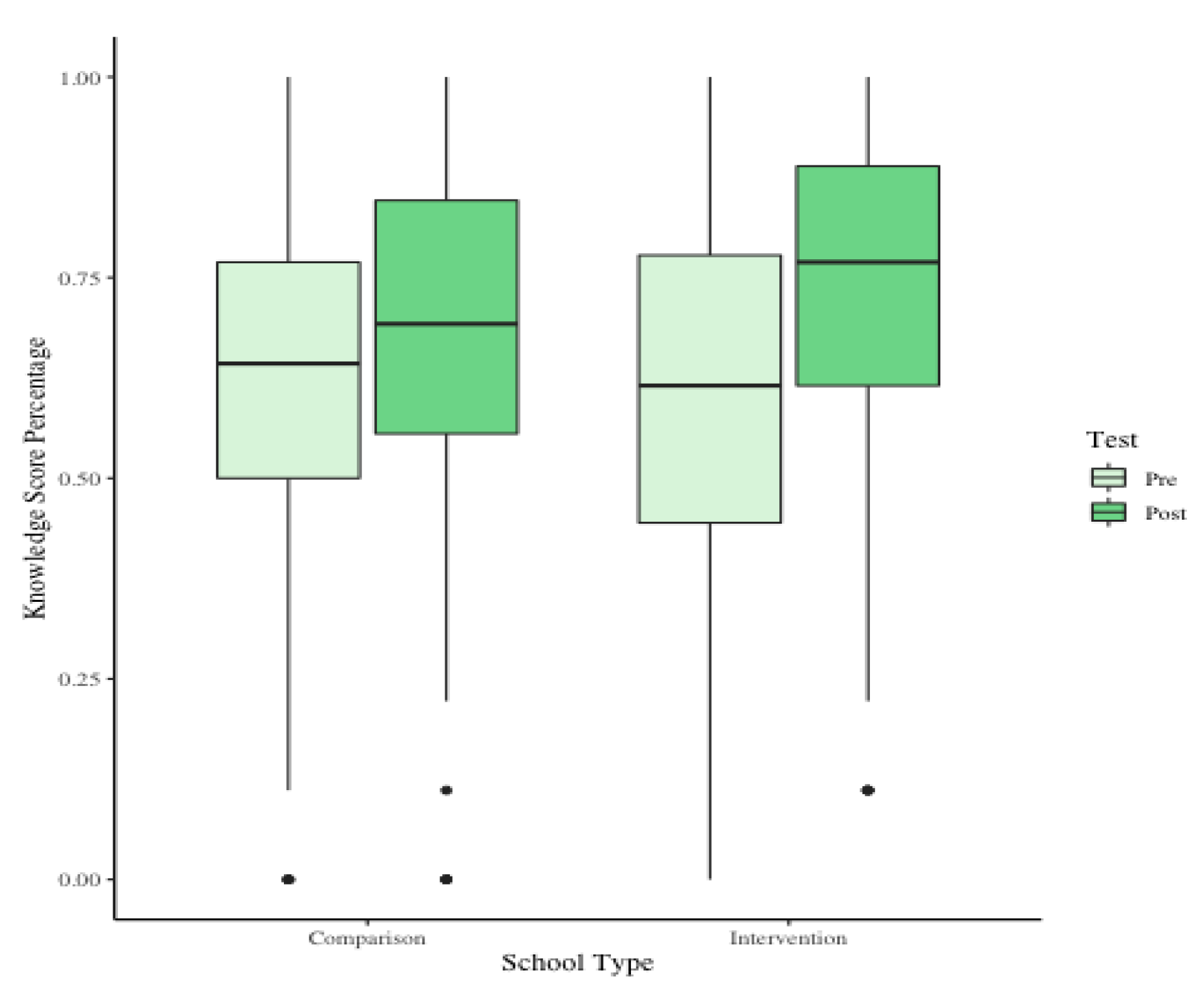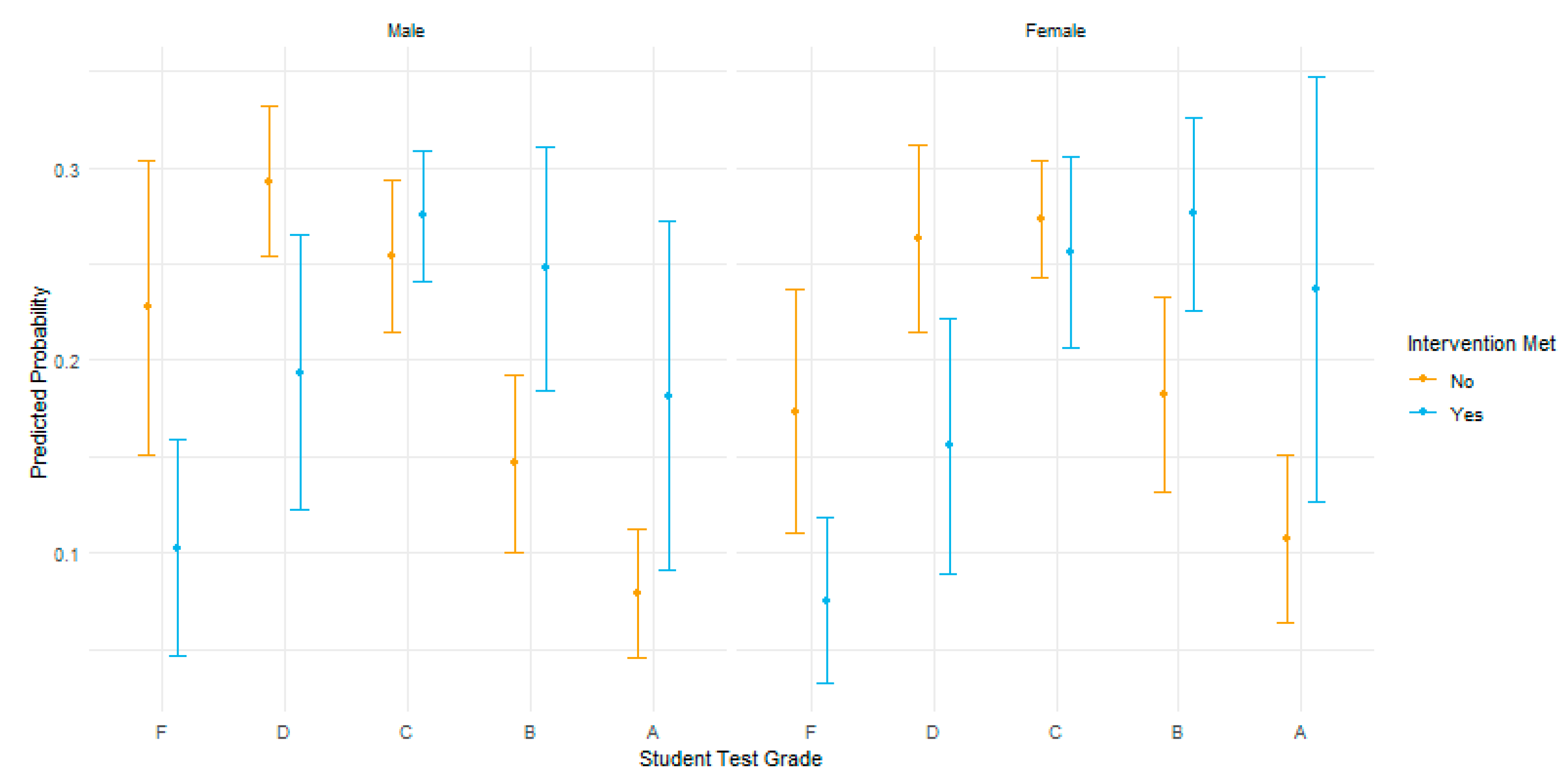Healthy Schoolhouse 2.0 Health Promotion Intervention to Reduce Childhood Obesity in Washington, DC: A Feasibility Study
Abstract
:1. Introduction
2. Materials and Methods
2.1. Participant and School Demographics
2.2. Teacher Health Survey (THS)
2.3. Student Nutrition Literacy Survey (SNLS)
2.4. Data Analysis Procedures
3. Results
3.1. Teachers
3.2. Student Nutrition Literacy Survey (SNLS)
3.3. Multilevel Ordinal Logistic Regression (OLR)
4. Discussion
4.1. Strengths and Limitations
4.2. Implications for Future Research
5. Conclusions
Supplementary Materials
Author Contributions
Funding
Institutional Review Board Statement
Informed Consent Statement
Data Availability Statement
Acknowledgments
Conflicts of Interest
References
- Braveman, P.; Barclay, C. Health Disparities Beginning in Childhood: A Life-Course Perspective. Pediatrics 2009, 124 (Suppl. 3), S163–S175. [Google Scholar] [CrossRef] [PubMed] [Green Version]
- Hales, C.M.; Carroll, M.D.; Fryar, C.D.; Ogden, C.L. Prevalence of obesity among adults and youth: United States, 2015–2016. Hyattsville, MD: National Center for Health Statistics. NCHS Data Brief. 2017, 288, 1–8. [Google Scholar]
- Our Healthy DC. Available online: https://ourhealthydc.org/dc-chna/health-outcomes/infant-child-health/ (accessed on 28 July 2021).
- US Dept of Agriculture. Nutrition Standards in the National School Lunch and School Breakfast Programs: Final Rule. Available online: https://www.fns.usda.gov/federal_register?rin%5B0%5D=0584-AD59%20 (accessed on 28 July 2021).
- Healthy, Hunger-Free Kids Act of 2010, Pub. L. No. 111-296, 124 Stat. 3183. 2010. Available online: http://www.nea.org/assets/docs/HHFKA_fact_sheet-final(1).pdf (accessed on 28 July 2021).
- Every Student Succeeds Act, Pub. L. No. 114-95, 129 Stat. 1802. 2015. Available online: https://www.ed.gov/essa?src=rn (accessed on 1 July 2021).
- CDC Healthy Schools. Whole School, Whole Community, Whole Child (WSCC). Available online: https://www.cdc.gov/healthyschools/wscc/index.htm (accessed on 28 July 2021).
- Office of the State Superintendent of Education. Healthy Schools Act. Available online: https://osse.dc.gov/service/healthy-schools-act (accessed on 28 July 2021).
- Liu, Z.; Xu, H.M.; Wen, L.M.; Peng, Y.Z.; Lin, L.Z.; Zhou, S.; Li, W.H.; Wang, H.J. A systematic review and meta-analysis of the overall effects of school-based obesity prevention interventions and effect differences by intervention components. Int. J. Behav. Nutr. Phys. Act. 2019, 16, 95. [Google Scholar] [CrossRef]
- Gonzalez-Suarez, C.; Worley, A.; Grimmer-Somers, K.; Dones, V. School-based interventions on childhood obesity: A meta-analysis. Am. J. Prev. Med. 2009, 37, 418–427. [Google Scholar] [CrossRef]
- Verrotti, A.; Penta, L.; Zenzeri, L.; Agostinelli, S.; Feo, P.D. Childhood obesity: Prevention and strategies of intervention. A systematic review of school-based interventions in primary schools. J. Endocrinol. Investig. 2014, 37, 1155–1164. [Google Scholar] [CrossRef] [PubMed]
- Snelling, A.; Newman, C.; Watts, E.; van Dyke, H.; Malloy, E.J.; Ghamarian, Y.; Guthrie, J.; Mancino, L. Pairing fruit and vegetables to promote consumption in elementary school cafeterias. J. Child. Nutr. Manag. 2017, 41, 1–13. [Google Scholar]
- Snelling, A.; Newman, C.; Ellsworth, D.; Kalicki, M.; Guthrie, J.F.; Mancino, L.; Malloy, E.J.; van Dyke, H.; George, S.; Nash, K. Engaging elementary students with taste tests to promote vegetable consumption. Health Behav. Policy Rev. 2017, 4, 67–75. [Google Scholar] [CrossRef]
- Snelling, A.; Belson, S.I.; Beard, J.; Young, K. Associations between grades and physical activity and food choices: Results from YRBS from a large school district. Health Educ. 2015, 115, 141–151. [Google Scholar] [CrossRef]
- Michael, S.L.; Merlo, C.L.; Basch, C.E.; Wentzel, K.R.; Wechsler, H. Critical Connections: Health and academics. J. Sch. Health 2015, 85, 740–758. [Google Scholar] [CrossRef] [PubMed] [Green Version]
- CDC Adolescent and School Health. Health and Academic Achievement. Available online: https://www.cdc.gov/healthyyouth/health_and_academics/pdf/health-academic-achievement.pdf (accessed on 28 July 2021).
- Schmitt, S.A.; Bryant, L.M.; Korucu, I.; Kirkham, L.; Katare, B.; Benjamin, T. The effects of a nutrition education curriculum on improving young children’s fruit and vegetable preferences and nutrition and health knowledge. Public Health Nutr. 2018, 22, 28–34. [Google Scholar] [CrossRef] [Green Version]
- Wall, D.E.; Least, C.; Gromis, J.; Lohse, B. Nutrition education intervention improves vegetable-related attitude, self-efficacy, preference, and knowledge of fourth-grade students. J. Sch. Health 2012, 82, 37–43. [Google Scholar] [CrossRef]
- Kulik, N.L.; Moore, E.W.; Centeio, E.E.; Garn, A.C.; Martin, J.J.; Shen, B.; Somers, C.L.; McCaughtry, N. Knowledge, Attitudes, Self-Efficacy, and Healthy Eating Behavior Among Children: Results From the Building Healthy Communities Trial. Health Educ. Behav. 2019, 46, 602–611. [Google Scholar] [CrossRef]
- Cotton, W.; Dudley, D.; Peralta, L.; Werkhoven, T. The effect of teacher-delivered nutrition education programs on elementary- aged students: An updated systematic review and meta-analysis. Prev. Med. Rep. 2020, 20. [Google Scholar] [CrossRef] [PubMed]
- Darling-Hammond, L.; Hyler, M.E.; Gardner, M. Effective Teacher Professional Development. Learn. Policy Inst. 2017. Available online: https://learningpolicyinstitute.org/sites/default/files/product-files/Effective_Teacher_Professional_Development_REPORT.pdf (accessed on 28 July 2021).
- Metos, J.M.; Sarnoff, K.; Jordan, K.C. Teachers’ perceived and desired roles in nutrition education. J. Sch. Health 2019, 89, 68–76. [Google Scholar] [CrossRef] [PubMed] [Green Version]
- Snelling, A.; Belson, S.I.; Young, J. School health reform: Investigating the role of teachers. J. Child. Nutr. Manag. 2012, 36, 6. [Google Scholar]
- Snelling, A.; Ernst, J.; Belson, S.I. Teachers as role models in solving childhood obesity. J. Pediatr. Biochem. 2013, 3, 55–60. [Google Scholar] [CrossRef]
- Perera, T.; Frei, S.; Frei, B.; Wong, S.S.; Bobe, G. Improving nutrition education in U.S. Elementary schools: Challenges and opportunities. J. Educ. Pr. 2015, 6, 41–50. [Google Scholar]
- Hawkins, M.; Watts, E.; Belson, S.I.; Snelling, A. Design and Implementation of a 5-year School-based Nutrition Education Intervention. J. Nutr. Educ. Behav. 2020, 52, 421–428. [Google Scholar] [CrossRef]
- Bronfenbrenner, U. The Ecology of Human Development; Harvard University Press: Cambridge, MA, USA, 1981; p. 352. [Google Scholar]
- US Dept of Agriculture, Food and Nutrition Service. Serving Up My Plate: A Yummy Curriculum. Available online: https://www.fns.usda.gov/tn/serving-myplate-yummy-curriculum (accessed on 28 July 2021).
- Hawkins, M.; Fuchs, H.; Watts, E.; Belson, S.I.; Snelling, A. Development of a nutrition literacy survey for use among elementary school students in communities with high rates of food insecurity. J. Hunger Environ. Nutr. 2021. [Google Scholar] [CrossRef]
- Byrd-Williams, C. Best practices and barriers to obesity prevention in Head Start: Differences between director and teacher perceptions. Prev. Chronic Dis. 2017, 14. [Google Scholar] [CrossRef] [Green Version]
- R Core Team. R: A Language and Environment for Statistical Computing. R Foundation for Statistical Computing. 2021. Available online: https://www.R-project.org/ (accessed on 28 July 2021).
- Christensen, R.H.B. Ordinal—Regression Models for Ordinal Data. R Package Version 2019.12-10. 2019. Available online: https://CRAN.R-project.org/package=ordinal (accessed on 28 July 2021).
- Van Buuren, S.; Groothuis-Oudshoorn, K. Mice: Multivariate Imputation by Chained Equations in R. J. Stat. Softw. 2011, 45, 1–67. [Google Scholar] [CrossRef] [Green Version]
- Healthy Eating Research. Prioritizing Health in State ESSA Plans and Report Cards to Support the Whole Child. Chicago, IL: Institute for Healthy Research and Policy UIC. 2020. Available online: https://healthyeatingresearch.org/research/prioritizing-health-in-state-essa-plans-and-report-cards-to-support-the-whole-child/ (accessed on 28 July 2021).
- Ickovics, J.R.; Duffany, K.O.; Shebl, F.M.; Peters, S.M.; Read, M.A.; Gilstad-Hayden, K.R.; Schwartz, M.B. Implementing School-Based Policies to Prevent Obesity: Cluster Randomized Trial. Am. J. Prev. Med. 2019, 56, e1–e11. [Google Scholar] [CrossRef] [PubMed]
- Killian, C.M.; Kern, B.D.; Ellison, D.W.; Graber, K.C.; Woods, A.M. State lawmaker’s views on childhood obesity and related school wellness legislation. J. Sch. Health 2020, 90, 257–263. [Google Scholar] [CrossRef] [PubMed]
- Tucker, C.M.; Zayco, R.A.; Herman, K.C.; Reinke, W.M.; Trujillo, M.; Carraway, K.; Wallack, C.; Ivery, P.D. Teacher and child variables as predictors of academic engagement among low-income African American children. Psychol. Sch. 2002, 39, 477–488. [Google Scholar] [CrossRef]
- Putney, L.G.; Broughton, S.H. Developing collective classroom efficacy: The teacher’s role as community organizer. J. Teach. Educ. 2011, 62, 93–105. [Google Scholar] [CrossRef]
- Pickett, K.; Rietdijk, W.; Byrne, J.; Shepherd, J.; Roderick, P.; Grace, M. Teaching health education: A thematic analysis of early career teachers’ experiences following pre-service health training. Health Educ. 2017, 117, 323–340. [Google Scholar] [CrossRef] [Green Version]
- Watts, S.O.; Pinero, D.J.; Alter, M.M.; Lancaster, K.J. An Assessment of Nutrition Education in Selected Counties in New York State Elementary Schools (Kindergarten through Fifth Grade). J. Nutr. Educ. Behav. 2012, 44, 474–480. [Google Scholar] [CrossRef]



| # Schools | # Students | Grades | # Teachers |
|---|---|---|---|
| 4 (2 intervention, 2 comparison) | 1302 | 1st–5th | 55 |
| Intervention (n = 694) | Comparison (n = 608) | Total (n = 1302) | |||
|---|---|---|---|---|---|
| Intervention School 1 | Intervention School 2 | Comparison School 1 | Comparison School 2 | ||
| n (%) | n (%) | n (%) | n (%) | n (%) | |
| Gender | |||||
| Male | 202 (51.5%) | 137 (45.4%) | 157 (53.2%) | 167 (53.4%) | 663 (50.9%) |
| Female | 174 (44.4%) | 155 (51.3%) | 128 (43.4%) | 146 (46.6%) | 603 (46.3%) |
| Not Reported | 16 (4.1%) | 10 (3.3%) | 10 (3.4%) | 0 | 36 (2.3%) |
| Grade | |||||
| 1st | 121(30.9%) | 76 (25.2%) | 93 (31.52%) | 66 (21.1%) | 356 (27%) |
| 2nd | 82 (20.9%) | 53 (17.6%) | 51 (17.29%) | 60 (19.2%) | 246 (18.9%) |
| 3rd | 55 (14%) | 59 (19.5%) | 50 (16.95%) | 64 (20.4%) | 228 (17.5%) |
| 4th | 68 (17.4%) | 61 (20.2%) | 51 (17.29%) | 65 (20.8%) | 245 (18.8%) |
| 5th | 66 (16.8%) | 53 (17.5%) | 50 (16.95%) | 58 (18.5%) | 227 (17.4%) |
| Estimate | Odds Ratio | Std. Error | Z Value | |
|---|---|---|---|---|
| Intervention (Yes) | 0.95 *** | 2.58 | 0.25 | 3.75 |
| Test Exposure | 1.2 *** | 3.47 | 0.25 | 4.89 |
| Program Year | 0.39 *** | 1.48 | 0.11 | 3.49 |
| Test (Post) | 1.5 *** | 3.15 | 0.16 | 1.15 |
| Gender (Female) | 0.34 *** | 1.45 | 0.11 | 3.11 |
| Test Exposure and Program Year | 0.38 *** | 0.68 | 0.09 | −4.13 |
| Test Exposure and Test (Post) | 0.44 *** | 0.64 | 0.11 | −4.127 |
Publisher’s Note: MDPI stays neutral with regard to jurisdictional claims in published maps and institutional affiliations. |
© 2021 by the authors. Licensee MDPI, Basel, Switzerland. This article is an open access article distributed under the terms and conditions of the Creative Commons Attribution (CC BY) license (https://creativecommons.org/licenses/by/4.0/).
Share and Cite
Hawkins, M.; Belson, S.I.; McClave, R.; Kohls, L.; Little, S.; Snelling, A. Healthy Schoolhouse 2.0 Health Promotion Intervention to Reduce Childhood Obesity in Washington, DC: A Feasibility Study. Nutrients 2021, 13, 2935. https://doi.org/10.3390/nu13092935
Hawkins M, Belson SI, McClave R, Kohls L, Little S, Snelling A. Healthy Schoolhouse 2.0 Health Promotion Intervention to Reduce Childhood Obesity in Washington, DC: A Feasibility Study. Nutrients. 2021; 13(9):2935. https://doi.org/10.3390/nu13092935
Chicago/Turabian StyleHawkins, Melissa, Sarah Irvine Belson, Robin McClave, Lauren Kohls, Sarah Little, and Anastasia Snelling. 2021. "Healthy Schoolhouse 2.0 Health Promotion Intervention to Reduce Childhood Obesity in Washington, DC: A Feasibility Study" Nutrients 13, no. 9: 2935. https://doi.org/10.3390/nu13092935
APA StyleHawkins, M., Belson, S. I., McClave, R., Kohls, L., Little, S., & Snelling, A. (2021). Healthy Schoolhouse 2.0 Health Promotion Intervention to Reduce Childhood Obesity in Washington, DC: A Feasibility Study. Nutrients, 13(9), 2935. https://doi.org/10.3390/nu13092935






